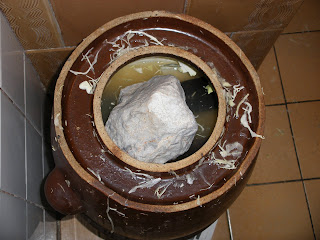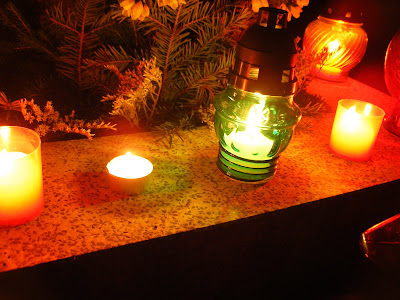 or, I Gotta Feeling That Tonight's Gonna Be a Good Night
or, I Gotta Feeling That Tonight's Gonna Be a Good NightFrom Tisovec to Budapest is less than 200 kilometers as the crow flies. In one's own car,
Via Michelin believes that it would take less than three and a half hours to travel that distance. On two buses and two trains, it took close to seven hours to get there on Friday afternoon, and three trains, one bus, and about nine hours to get back on Sunday. This is the reason why I had not yet been to Budapest. It is also the reason why I might not go back.
On Friday night, on a train drawing ever closer to the city, I realized that I had no idea what I was getting into. Yes, I knew where Budapest is, and I had some vague idea about the kinds of things that we might see, but not much. I'd barely glanced at a guidebook, hadn't really looked at any websites, and knew zero words of Hungarian. By the time we got to Nyugati station, I was very nervous. I'd never before been to a country where I had
no idea how to say at least "please" or "thank you," which is the absolute minimum that you should know when traveling abroad. (Despite the geographical closeness, there is a huge difference between the Slovak and Hungarian languages.) This is not a situation I want to repeat, either. It was my own fault for not investigating these things beforehand. But in the words of
one of the other teachers, "Well, now we know."
All seven of us from Tisovec were traveling together, and meeting two other teachers in Budapest. This was a much larger group of people than I'm used to traveling with, and the numbers presented some challenges. Although it took what seemed like about three hours on Friday night to find one of our people and the hostel, we got there eventually. The trip was not without "speed bumps," some of which could have been avoided. Was it still worthwhile, and fairly fun? Yes and yes. On a scale of 1 to 10, 10 being "I never want to leave" and 1 being "I must leave this place immediately," I rated the trip a 6.

Budapest is the capital of Hungary. It was only in 1873 that Buda and Pest were joined into one city. The two halves are separated by the Danube, and therefore there are several major bridges. The most photographed is the Chain Bridge. During World War II, all of the city's bridges were destroyed. Although Budapest is the capital today (the Parliament building is pictured above), during the Austro-Hungarian empire it was not necessarily a very important city. The relationship between Slovaks and Hungarians has not been smooth, either. Before we left school, one of the Slovak teachers half- (or three-quarters-) jokingly told us to enjoy the country that had oppressed the Slovaks for centuries.
Hungary is part of the EU, but does not use the euro. The currency is the forint, abbreviated ft. or huf. The exchange rate is something like 267 ft. to one euro. I took 10,000 ft. out of the ATM when we arrived on Friday night. Some of us developed a quick--some might even say immediate--dislike for the forint, mostly because to buy tram tickets you had to have coins no larger than 100 ft., and try to get that from breaking a 10,000 ft. bill.

On Saturday morning, after grabbing some breakfast at a store, we headed to Castle Hill in Buda. None of the buildings there are terribly old (read: medieval), but there are still some cool things. We did a "Tour de Doors," because there were some really, really sweet doors there. My other favorite things were the Fisherman's Bastion and Matthias Church. Fisherman's Bastion is this huge turreted terrace-like area that looks out over the river and has good views of Parliament and the Chain Bridge. The Bastion is made of white stone and it's pretty cool. There's a big statue, presumably a fountain, of Matthias Corvinus there. Don't worry if you've never heard of him; I only know a little about him from the history maturita last year. He was a king of Hungary during the 15th century, and apparently a pretty good one. One of the symbols of Hungary that appears on a forint coin and on Matthias Church is the raven. My theory, which I feel is fairly strong, is that the raven is a symbol of Corvinus because its genus is
Corvus. There's at least one raven statue perched on a spire of the church.

We walked around the outside of the church, which is surrounded by scaffolding and a bit obscured from view, so for a while I wasn't sure if it was actually open. Tickets weren't too expensive, but I still took a moment to ponder whether or not I should go in. Eventually I decided to go on in, and one of the other girls came with me. It was obviously the right decision; it is obviously always the right decision, and I don't know why I even had to think about it. I walked into the church and was so delighted that tears came to my eyes. (This is not an uncommon reaction for me upon walking into a cathedral.) Matthias Church is decorated in a style different than what I'm used to seeing in most cathedrals. Unlike the traditional European cathedral with the occasional fresco on mostly bare stone walls, the walls of Matthias Church are covered in painted designs. It was not what I expected, which is part of what was cool. I walked out vowing to never again doubt that I should go in any church.

After the morning on Castle Hill, we reconvened in Pest outside St. Stephen's Basilica. St. Stephen's is quite the opposite of Matthias Church. It's much newer, much more Baroque, and the inside has lots of gilt and marble. It was pretty, but I prefered Matthias. We tried to make it to the big central market, but it closed a few minutes after we arrived, so we didn't really have time to see much. It would have been nice to look around in. The first floor seemed to be mainly the fresh food stalls, and the upper floor had some restaurants and craft stalls. Since we didn't get to do any browsing there, we went out again and wandered up and down the street in front of the market.
That afternoon most of us headed to the Terror House, while some of us went shopping in other places. I didn't know what the Terror House really was; it sounded like it was going to be a museum of torture, and though I've been to those before, I hadn't seen one in a while, so I decided to go. It turned out to be something much more somber, because the Terror House explains the situation in Hungary during World War II and the Communist period. Long story short: it sucked. That was not at all a good time to live anywhere in central Europe. The museum had good exhibits and extensive handouts in English to explain everything.
We ate dinner at a café with outdoor seating, which was quit

e comfortable. The new thing that we've noticed for these places is to have the outdoor heaters, but also fleece blankets with the chairs. That way you can be all cozy while you dine. Because we were in Hungary, I felt it necessary to have lamb goulash, which was good, but not as good as some of the homemade gulaš I've had here. And because someone had mentioned it earlier, and I'd been limping around Budapest all day, I felt it necessary to have Jack Daniels and Coke. I do not regret it.
Once dinner was finished we headed over to take pictures of the Chain Bridge lit up at night. As we were finishing our photography it began to rain, and our shoes were fairly soaked by the time we reached the hostel again. They were mostly dry by the next morning, though.
On Sunday morning we again split up. My group went first to see Heroes Square, which, as the name suggests, is a square with a big monument to Hungarian heroes throughout history. Since none of us are well-versed in Hungarian history, much of the cultural significance of the monument was lost on us. So after a few moments there, we went to check out an interesting-looking building that turned out to be the Museum of Hungarian Agriculture. Then we headed back toward the river to get some coffee before church. I inadvertently got a drink with actual coffee in it, which led to me being
really nervous later in the day instead of just somewhat nervous. It was good coffee, though.

In Buda there is a small Catholic church in a cave. We made it to Mass there at 11 o'clock. I've been to a few Catholic masses before, and this one was not much different, because at all of them, everyone knows what's going on without having to consult their hymnal. We, on the other hand, were trying to figure out a different service in a different language. It took me at least halfway through the liturgy to find where to follow along. We were impressed with the priest, who gave his sermon without having to refer to his notes very much at all. The cave was also surprisingly warm. I must admit that reading and listening to the Hungarian language in the service made me think of Tolkien's invented languages from the
Lord of the Rings trilogy. It turns out that Hungarian is in the same linguistic family as Finnish, which Tolkien apparently really loved; so that makes sense. In the picture below, the entrance to the church is behind the gate on the left.

Once church was done we had to book it to the train station. For a moment it seemed like we would have to leave some of our number behind; and even though they'd be able to get a later train that went to Košice, I didn't like the idea. But we all found each other and bought our tickets, despite the ridiculous ticket windows. (There was a sign that said "Take a number" with no number-dispensing apparatus in sight. The two ticket windows had no customers at them, so we walked up, only to be told that we needed numbers. It took us a minute to find the machine that printed the numbers so that we could go buy our tickets.) We got on our train, and then we got to Slovakia and took two more trains and then a bus before we got to Tisovec.
One of the girls this year often uses superlatives; a class is "THE CRAZIEST!" or cake has "THE MOST POPPYSEED!", and I love it. When we disembarked in Tisovec, we looked at each other and started declaring that we were, indeed, THE HAPPIEST to be back home, with our hills and our sheep.

On that first bus from Tisovec to Nitra, we heard the Black Eyed Peas song "
I Gotta Feeling." As this post's subtitle says, the burden of the song is, "I gotta feeling that tonight's gonna be a good night." The song was stuck in my head in fits and starts over the weekend, which might sound unbearable. But even when things were most stressful, I still knew that everything would be okay. I have no desire to relive this past weekend, but at the same time, I'm glad I went.

















































